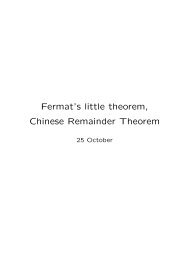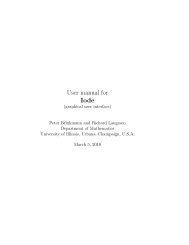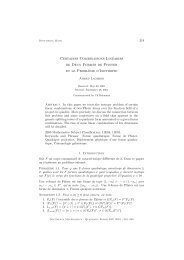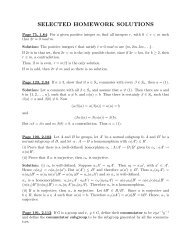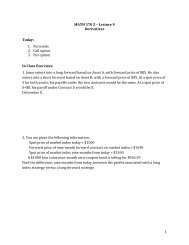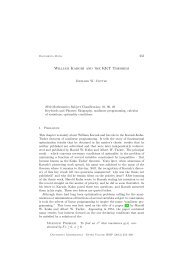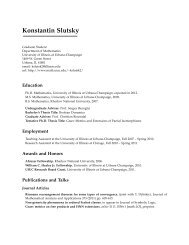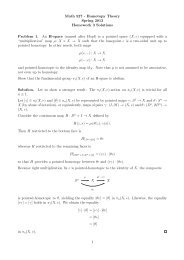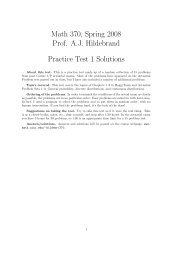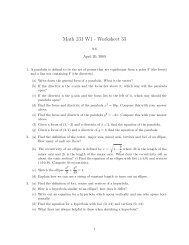16 BRUCE C. BERNDT AND HENG HUAT CHAN This implies, by (5.1), that (5.3) 2z dz dJ = where Ak := By (4.5) <strong>and</strong> (4.7), we deduce that (5.4) 2z dz 1 = dJ 6J ∞ AkkJ k−1 , k=1 1 6 k 5 6 k (k!) 3 1 2 k P √ − z 1 − J 2 . Substituting (5.4) in<strong>to</strong> (5.3) <strong>and</strong> using (5.2), we deduce that (5.5) P √ 1 − J = ∞ Ak(6k + 1)J k . k=0 Next, set q = e −π√ n <strong>and</strong> deduce from (5.5) that (5.6) Pn √ = 1 − Jn ∞ Ak(6k + 1)J k n. k=0 On the other h<strong>and</strong>, by Theorem 4.1 <strong>and</strong> (4.1), (5.7) Pn = 6 π √ n + z2 n 1 − Jntn. Using (5.7), (5.2) (with z replaced by zn <strong>and</strong> J replaced by Jn) <strong>and</strong> (5.6), we conclude that 6 1 (5.8) √ √ n 1 − Jn π = ∞ 1 5 1 6 k 6 k 2 k (k!) 3 J k n(6k + 1 − tn). k=0 It can be shown that (5.8) is equivalent <strong>to</strong> the Ramanujan–Borweins–Chudnovskys <strong>series</strong>. The <strong>series</strong> (5.8) enables us <strong>to</strong> write down for each n, a <strong>series</strong> for 1/π if we know the values of tn <strong>and</strong> Jn. We have already determined the value of t3315 in Section 4. It suffices <strong>to</strong> compute J3315 in order <strong>to</strong> write down a <strong>series</strong> for 1/π associated with n = 3315. We first quote the identity [4], [5] √ 3 + −3n (5.9) j 2 = −27 (λ2n − 1)(9λ2 n − 1) 3 λ2 , n .
where APPROXIMATIONS TO π 17 λn = eπ√ n/2 3 √ 3 f 6 (e −π√ n/3 ) f 6 (e −π√ 3n ) , where f(−q) is defined prior <strong>to</strong> (4.25). Since [5] λ 2 1105 = √ 5 + 1 2 24 (4 + √ 17) 6 15 + √ 6 221 (8 + 2 √ 65) 6 , the value of J3315 follows immediately from (5.9). The values J3315 <strong>and</strong> t3315, when substituted in<strong>to</strong> (5.8), yield the <strong>series</strong> which we mentioned at the end of Section 4. Acknowledgement. We are grateful <strong>to</strong> Seung Hwan Son for hel<strong>pi</strong>ng us find the correct value of q for the linear equations in Q 3 <strong>and</strong> R 2 . The first author is grateful <strong>to</strong> the National University of Singapore for financially supporting his visit there when this research was conducted. References 1. G. E. Andrews, R. A. Askey, <strong>and</strong> R. Roy, Special Functions, Cambridge University Press, Cambridge, 1999. 2. B. C. Berndt, Ramanujan’s Notebooks, Part III, Springer–Verlag, New York, 1991. 3. B. C. Berndt, Ramanujan’s Notebooks, Part V, Springer–Verlag, New York, 1998. 4. B. C. Berndt <strong>and</strong> H. H. Chan, Ramanujan <strong>and</strong> the modular j–invariant, Canad. Math. Bull. 42 (1999), 427–440. 5. B. C. Berndt, H. H. Chan, S.–Y. Kang, <strong>and</strong> L.–C. Zhang, A certain quotient of eta-functions found in Ramanujan’s lost notebook,, Pacific J. Math. (<strong>to</strong> appear). 6. J. M. Borwein <strong>and</strong> P. M. Borwein, Pi <strong>and</strong> the AGM, Wiley, New York, 1987. 7. J. M. Borwein <strong>and</strong> P. B. Borwein, Ramanujan’s rational <strong>and</strong> algebraic <strong>series</strong> for 1/π, Indian J. Math. 51 (1987), 147–160. 8. J. M. Borwein <strong>and</strong> P. M. Borwein, More Ramanujan-type <strong>series</strong> for 1/π, Ramanujan Revisited (G. E. Andrews, R. A. Askey, B. C. Berndt, K. G. Ramanathan, <strong>and</strong> R. A. Rankin, eds.), Academic Press, Bos<strong>to</strong>n, 1988, pp. 359–374. 9. J. M. Borwein <strong>and</strong> P. B. Borwein, Some observations on computer aided analysis, Notices Amer. Math. Soc. 39 (1992), 825–829. 10. H. H. Chan, On Ramanujan’s cubic transformation formula for 2F1(1/3, 2/3; 1; z), Math. Proc. Cambridge Philos. Soc. 124 (1998), 193–204. 11. H. H. Chan <strong>and</strong> Y. L. Ong, On <strong>Eisenstein</strong> <strong>series</strong> <strong>and</strong>∞ m,n=−∞ qm2 +mn+2n 2 , Proc. Amer. Math. Soc. 127 (1999), 1735–1744. 12. K. Ch<strong>and</strong>rasekharan, Elliptic Functions, Springer–Verlag, Berlin, 1985. 13. D. V. Chudnovsky <strong>and</strong> G. V. Chudnovsky, Approximation <strong>and</strong> complex multiplication according <strong>to</strong> Ramanujan, Ramanujan Revisited (G. E. Andrews, R. A. Askey, B. C. Berndt, K. G. Ramanathan, <strong>and</strong> R. A. Rankin, eds.), Academic Press, Bos<strong>to</strong>n, 1988, pp. 375–472. 14. D. A. Cox, Primes of the Form x2 + ny2 , Wiley, New York, 1989.




